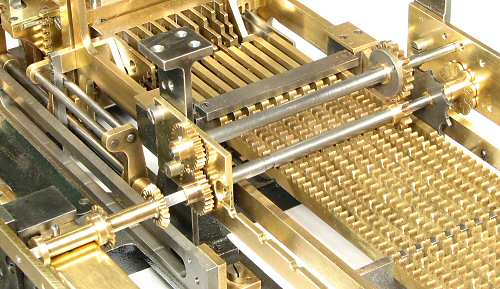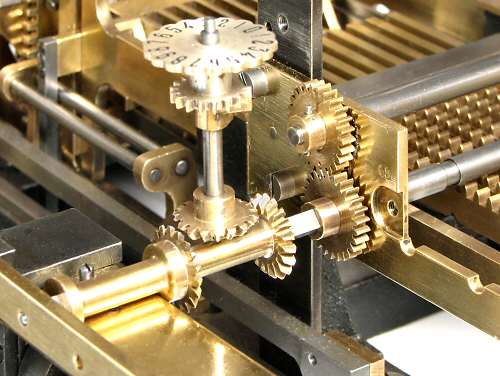 The counter cross-shafts.
The counter cross-shafts.
The Millionaire counter drive is a little more complicated than in a conventional mechanical calculator. It is not possible to just count the turns of the crank, as all functions are completed in just one turn.
The drive for the counter is taken from the No 1 rack. This "one times" rack never moves on the tens cycle, but travels a distance equal to the multiplier setting on the units cycle. The differential mechanism is still required to disengage the drive as the rack makes its return stroke.
To avoid the display of complements as the counter rotates backwards on division, the register dial is marked from 0 to 9 in both directions. The drive must be divided down to produce only half a turn for 9 steps of the rack.
 The counter cross-shafts.
The counter cross-shafts.
The counter register is driven by an arrangement of three shafts located one place to the left of the accumulator cross-shafts. (The lower shaft is in two separate sections which share a common centre bearing).
The lower rear cross-shaft has the same detent and star wheel as the accumulator shafts, but has only a single pinion which is permanently engaged with Rack 1.
The rotation of the lower shaft is halved by the 2:1 reduction gearing, and is transmitted through the top shaft and 1:1 gearset to the short square-section cross-shaft at the front.
The key-set machines have a steel cam attached to the front face of the 20-tooth reduction gear. The cam operates a mechanism which can be set to automatically clear the keyboard following an addition or subtraction.
 The counter register differential.
The counter register differential.
The counter register in the carriage is located 28mm to the rear of the accumulator register. The counter differential is extended to this position by a sleeve which sits over the shifting plate.
With the carriage in its normal (rightmost) position, the counter drive mechanism in the 9th position is "off the end" of the 8 register dials. This does not present a problem in multiplication, as the counter registration occurs during the units cycle, after the carriage has moved one place to the left.
During addition and subtraction the carriage remains in its rightmost position. The counter mechanism still operates, but there is no register dial to receive the indication.